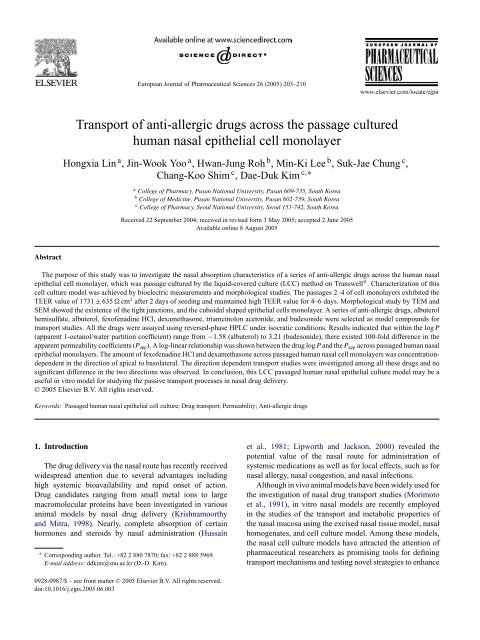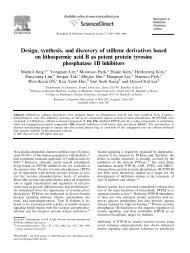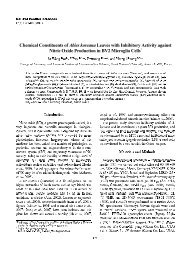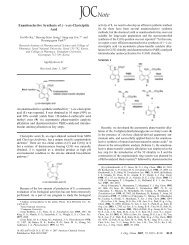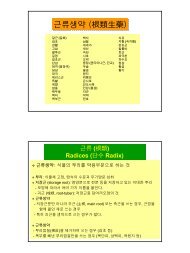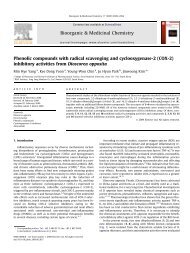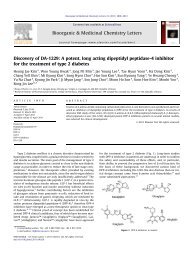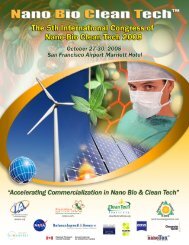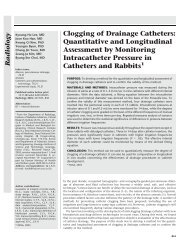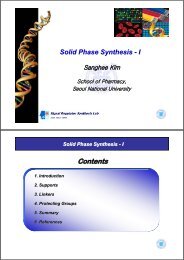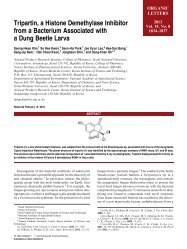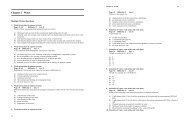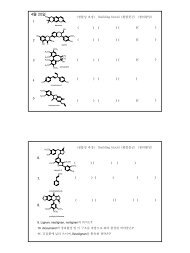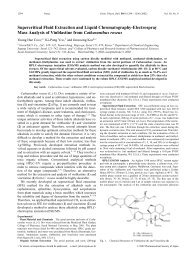Transport of anti-allergic drugs across the passage cultured human ...
Transport of anti-allergic drugs across the passage cultured human ...
Transport of anti-allergic drugs across the passage cultured human ...
You also want an ePaper? Increase the reach of your titles
YUMPU automatically turns print PDFs into web optimized ePapers that Google loves.
European Journal <strong>of</strong> Pharmaceutical Sciences 26 (2005) 203–210<strong>Transport</strong> <strong>of</strong> <strong>anti</strong>-<strong>allergic</strong> <strong>drugs</strong> <strong>across</strong> <strong>the</strong> <strong>passage</strong> <strong>cultured</strong><strong>human</strong> nasal epi<strong>the</strong>lial cell monolayerHongxia Lin a , Jin-Wook Yoo a , Hwan-Jung Roh b , Min-Ki Lee b , Suk-Jae Chung c ,Chang-Koo Shim c , Dae-Duk Kim c,∗a College <strong>of</strong> Pharmacy, Pusan National University, Pusan 609-735, South Koreab College <strong>of</strong> Medicine, Pusan National University, Pusan 602-739, South Koreac College <strong>of</strong> Pharmacy, Seoul National University, Seoul 151-742, South KoreaReceived 22 September 2004; received in revised form 3 May 2005; accepted 2 June 2005Available online 8 August 2005AbstractThe purpose <strong>of</strong> this study was to investigate <strong>the</strong> nasal absorption characteristics <strong>of</strong> a series <strong>of</strong> <strong>anti</strong>-<strong>allergic</strong> <strong>drugs</strong> <strong>across</strong> <strong>the</strong> <strong>human</strong> nasalepi<strong>the</strong>lial cell monolayer, which was <strong>passage</strong> <strong>cultured</strong> by <strong>the</strong> liquid-covered culture (LCC) method on Transwell ® . Characterization <strong>of</strong> thiscell culture model was achieved by bioelectric measurements and morphological studies. The <strong>passage</strong>s 2–4 <strong>of</strong> cell monolayers exhibited <strong>the</strong>TEER value <strong>of</strong> 1731 ± 635 cm 2 after 2 days <strong>of</strong> seeding and maintained high TEER value for 4–6 days. Morphological study by TEM andSEM showed <strong>the</strong> existence <strong>of</strong> <strong>the</strong> tight junctions, and <strong>the</strong> cuboidal shaped epi<strong>the</strong>lial cells monolayer. A series <strong>of</strong> <strong>anti</strong>-<strong>allergic</strong> <strong>drugs</strong>, albuterolhemisulfate, albuterol, fex<strong>of</strong>enadine HCl, dexamethasone, triamcinolon acetonide, and budesonide were selected as model compounds fortransport studies. All <strong>the</strong> <strong>drugs</strong> were assayed using reversed-phase HPLC under isocratic conditions. Results indicated that within <strong>the</strong> log P(apparent 1-octanol/water partition coefficient) range from −1.58 (albuterol) to 3.21 (budesonide), <strong>the</strong>re existed 100-fold difference in <strong>the</strong>apparent permeability coefficients (P app ). A log-linear relationship was shown between <strong>the</strong> drug log P and <strong>the</strong> P app <strong>across</strong> <strong>passage</strong>d <strong>human</strong> nasalepi<strong>the</strong>lial monolayers. The amount <strong>of</strong> fex<strong>of</strong>enadine HCl and dexamethasone <strong>across</strong> <strong>passage</strong>d <strong>human</strong> nasal cell monolayers was concentrationdependentin <strong>the</strong> direction <strong>of</strong> apical to basolateral. The direction dependent transport studies were investigated among all <strong>the</strong>se <strong>drugs</strong> and nosignificant difference in <strong>the</strong> two directions was observed. In conclusion, this LCC <strong>passage</strong>d <strong>human</strong> nasal epi<strong>the</strong>lial culture model may be auseful in vitro model for studying <strong>the</strong> passive transport processes in nasal drug delivery.© 2005 Elsevier B.V. All rights reserved.Keywords: Passaged <strong>human</strong> nasal epi<strong>the</strong>lial cell culture; Drug transport; Permeability; Anti-<strong>allergic</strong> <strong>drugs</strong>1. IntroductionThe drug delivery via <strong>the</strong> nasal route has recently receivedwidespread attention due to several advantages includinghigh systemic bioavailability and rapid onset <strong>of</strong> action.Drug candidates ranging from small metal ions to largemacromolecular proteins have been investigated in variousanimal models by nasal drug delivery (Krishnamoorthyand Mitra, 1998). Nearly, complete absorption <strong>of</strong> certainhormones and steroids by nasal administration (Hussain∗ Corresponding author. Tel.: +82 2 880 7870; fax: +82 2 888 5969.E-mail address: ddkim@snu.ac.kr (D.-D. Kim).et al., 1981; Lipworth and Jackson, 2000) revealed <strong>the</strong>potential value <strong>of</strong> <strong>the</strong> nasal route for administration <strong>of</strong>systemic medications as well as for local effects, such as fornasal allergy, nasal congestion, and nasal infections.Although in vivo animal models have been widely used for<strong>the</strong> investigation <strong>of</strong> nasal drug transport studies (Morimotoet al., 1991), in vitro nasal models are recently employedin <strong>the</strong> studies <strong>of</strong> <strong>the</strong> transport and metabolic properties <strong>of</strong><strong>the</strong> nasal mucosa using <strong>the</strong> excised nasal tissue model, nasalhomogenates, and cell culture model. Among <strong>the</strong>se models,<strong>the</strong> nasal cell culture models have attracted <strong>the</strong> attention <strong>of</strong>pharmaceutical researchers as promising tools for definingtransport mechanisms and testing novel strategies to enhance0928-0987/$ – see front matter © 2005 Elsevier B.V. All rights reserved.doi:10.1016/j.ejps.2005.06.003
204 H. Lin et al. / European Journal <strong>of</strong> Pharmaceutical Sciences 26 (2005) 203–210drug transport and absorption. Fur<strong>the</strong>rmore, primary culture<strong>of</strong> nasal epi<strong>the</strong>lial cells from a variety <strong>of</strong> species including<strong>human</strong>, bovine, rat, and rabbit can provide valuable invitro models in <strong>the</strong> study <strong>of</strong> nasal physiology. The culture<strong>of</strong> cells and tissue derived from differentiated <strong>human</strong> nasalepi<strong>the</strong>lium is an established tool for <strong>the</strong> studies <strong>of</strong> fibrosis,electrolyte transport, ciliogenesis, and ciliary movement(Ruckes et al., 1997; Jorissen and Bessems, 1995). In vitrocell culture models <strong>of</strong>fer many advantages, including: (a) acontrolled environment for <strong>the</strong> study <strong>of</strong> epi<strong>the</strong>lial cell growthand differentiation; (b) <strong>the</strong> elucidation <strong>of</strong> drug transport pathwaysand mechanisms; (c) rapid and convenient means <strong>of</strong>evaluating drug permeability; (d) opportunity to minimize <strong>the</strong>expensive and limited controversial use <strong>of</strong> animals (Schmidtet al., 1998). It has been reported that <strong>human</strong> nasal primarycultures as in vitro models show <strong>the</strong> potentials for <strong>the</strong> study<strong>of</strong> nasal drug absorption, especially for <strong>the</strong> peptide transportstudies (Werner and Kissel, 1995; Kissel and Werner, 1998;Agu et al., 2001).However, efforts to develop and characterize nasal cellculture systems for drug metabolism and permeation arestill in <strong>the</strong>ir infancy. The main limitation is <strong>the</strong> difficulty inobtaining a reliable tissue source, which hinders <strong>the</strong> usefulness<strong>of</strong> in vitro cell culture model especially if <strong>human</strong> tissueis preferred. In order to overcome <strong>the</strong> shortage <strong>of</strong> <strong>human</strong>nasal tissue, researchers have shifted from primary cultures<strong>of</strong> epi<strong>the</strong>lial cells to <strong>passage</strong> <strong>cultured</strong> cell lines. Transformation<strong>of</strong> <strong>human</strong> nasal polyp cells using a chimaeric virus(Ad5/SV40 1613 ori-) is one <strong>of</strong> <strong>the</strong> examples <strong>of</strong> <strong>the</strong> change intrends. The extended lifespans ranged from 20 to more than250 population doublings beyond that <strong>of</strong> <strong>the</strong> primary cultures(Buchanan et al., 1990). In a previous report, we have established<strong>the</strong> <strong>passage</strong>d <strong>human</strong> nasal epi<strong>the</strong>lial culture method for<strong>the</strong> drug transport studies (Yoo et al., 2003), where <strong>the</strong> LCCmethod was utilized and properties <strong>of</strong> nasal epi<strong>the</strong>lium wereinvestigated by bioelectric and morphological studies. Thecharacteristic high TEER value, which was an indication <strong>of</strong><strong>the</strong> formation <strong>of</strong> a tight junction formation, was maintainedup to <strong>the</strong> monolayers <strong>of</strong> <strong>passage</strong> 4. In order to verify <strong>the</strong> utility<strong>of</strong> this <strong>passage</strong>d culture model for actual nasal transepi<strong>the</strong>lialdrug delivery, a series <strong>of</strong> <strong>anti</strong>-<strong>allergic</strong> <strong>drugs</strong> were selectedfor transport studies and evaluated for <strong>the</strong> influence <strong>of</strong> druglipophilicity on solute permeability <strong>across</strong> <strong>the</strong> monolayers.The permeability characteristics <strong>of</strong> <strong>the</strong> model <strong>drugs</strong> <strong>across</strong><strong>the</strong> monolayers was compared with those <strong>of</strong> excised porcinenasal mucosa in <strong>the</strong> literatures to demonstrate <strong>the</strong> feasibility<strong>of</strong> <strong>the</strong> in vitro model for nasal drug transport studies.2. Materials and methods2.1. MaterialsDexamethasone was purchased from Wako Pure ChemicalIndustries Ltd. (Osaka, Japan). Albuterol hemisulfate,albuterol, budesonide, Hank’s balanced salt solution (HBSS),h-EGF, and d-(+)-glucose were purchased from SigmaChemical Co. (St. Louis, MO). Triamcinolone acetonide andfex<strong>of</strong>enadine HCl were gifts from Handok-Aventis PharmaceuticalCo. (Seoul, Korea). O<strong>the</strong>r cell culture reagents andsupplies were obtained from GIBCO Invitrogen Co. (GrandIsland, NY). BEGM Bulletkit was obtained from CambrexBio Science Inc. (Walkersville, MD), and Transwells ®(0.4 m, 12 mm diameter, polyester) were obtained fromCostar Co. (Cambridge, MA). All o<strong>the</strong>r materials were <strong>of</strong>analytical grade or better.2.2. Passage <strong>cultured</strong> <strong>human</strong> nasal epi<strong>the</strong>lial cellmethodThe primary <strong>human</strong> nasal cell culture method used in thisstudy has been described in detail previously (Roh et al.,1999). Human nasal specimens were obtained from patientsundergoing surgery due to septal deviation or chronic sinusitis,using a protocol approved by <strong>the</strong> Institutional ReviewBoard (IRB) at Pusan National University Hospital, SouthKorea. Briefly, <strong>the</strong> nasal specimens were dissociated enzymaticallyusing 1.0% protease XIV (Sigma, St. Louis, MO)overnight at 4 ◦ C. Dissociated epi<strong>the</strong>lial cells were washedthree times in DMEM containing 10% fetal bovine serumsupplemented with 100 U/mL penicillin and 100 g/mLstreptomycin. Cell suspension was pre-plated on a plastic dishat 37 ◦ C for 1 h in order to eliminate fibroblasts and myoblastsby differential attachment to plastic dish. Suspended epi<strong>the</strong>lialcells were frozen and stored in liquid nitrogen tank forfuture usages. Frozen <strong>passage</strong>-1 stocks were thawed and <strong>cultured</strong>in T-flask using BEGM at 37 ◦ C in an atmosphere <strong>of</strong> 5%CO 2 and 95% relative humidity. The medium was changedevery 2 days.When cultures reached approximately 70–80% confluency,<strong>the</strong> cells were detached with 0.1% trypsin–EDTA, andwere seeded at densities <strong>of</strong> 2 × 10 5 to 3 × 10 5 cells/cm 2 onTranswell ® insert with 0.5 mL BEGM in <strong>the</strong> apical chamberand 1.5 mL DMEM (supplemented with 10% FBS, 100 U/mLpenicillin, 100 g/mL streptomycin, 1 ng/mL EGF, 1% nonessentialamino acid, and 1% l-glutamine) in <strong>the</strong> basolateralchamber. After 24 h, media were changed with DMEM inboth <strong>the</strong> apical and basolateral sides and <strong>the</strong> cells were maintainedin <strong>the</strong> medium by changing <strong>the</strong> medium every 2 days.Remaining cells after seeding were subsequently sub<strong>cultured</strong>using BEGM for <strong>the</strong> next <strong>passage</strong>. The subculture density was500 cells/cm 2 and <strong>the</strong> media were changed every o<strong>the</strong>r day.2.3. Measurement <strong>of</strong> bioelectric parameters andmorphological studiesThe transepi<strong>the</strong>lial electrical resistance (TEER) was measureddaily by directly reading <strong>the</strong> values <strong>of</strong> an EVOMvoltohmmeter device (WPI, Sarasota, FL), and corrected bysubtracting <strong>the</strong> background due to <strong>the</strong> blank Transwell insertsand medium.
H. Lin et al. / European Journal <strong>of</strong> Pharmaceutical Sciences 26 (2005) 203–210 205Scanning (SEM) and transmission (TEM) electronmicroscopy were processed for morphological studies on day5. For SEM, each monolayer was fixed in 2.5% glutaraldehydein PBS at 4 ◦ C for 1 h, rinsed in ice-cold PBS, and <strong>the</strong>nfixed in 1.0% osmium tetroxide in PBS at room temperaturefor 1 h. The specimens were dehydrated through an alcoholseries and allowed to air-dry overnight. The specimenswere mounted on stubs with adhesive tape, sputter coated,and viewed in a Hitachi S-4200 scanning electron microscope(Hitachi, Japan). For TEM, <strong>the</strong> specimens were fixedas SEM. After dehydration, <strong>the</strong> specimens were embedded inEpon 812 semi-thin sections (80 nm), stained with toluidinblue and observed by light microscopy. Appropriate areaswere selected for ultra-thin sections, which were treated withuranyl acetate for 6 min and treated with lead citrate for 3 min.These sections were viewed under a JEM 1200 EXII electronmicroscope (Jeol, Japan).2.4. Physicochemical characteristics <strong>of</strong> <strong>anti</strong>-<strong>allergic</strong><strong>drugs</strong>The solubility <strong>of</strong> model <strong>drugs</strong> in transport medium wasmeasured at room temperature. Excess amount <strong>of</strong> each compoundwas added to 2 mL <strong>of</strong> transport medium, and <strong>the</strong>mixtures were stirred for 24 h. After filtering through MinisartRC 4 filter (0.45 m, Satorius, Germany), solutions wereanalyzed by HPLC after appropriate dilution with methanol.Apparent 1-octanol/water partition coefficient (log P)<strong>of</strong> model <strong>drugs</strong> was determined at room temperature, asreported in <strong>the</strong> literature (Dearden and Bresnen, 1988). An1-octanol/water mutual saturation was prepared for 24 h withgentle mechanical stirring, and each phase was separated. The100 L methanolic solution <strong>of</strong> each model drug (1 mg/mL)was placed in a glass vial and completely evaporated, and<strong>the</strong>n 1.0 mL <strong>of</strong> each saturated solvent was added to <strong>the</strong> vial.After shaking <strong>the</strong> vial for 24 h at 150 rpm, <strong>the</strong> phases wereseparated by centrifugation at 4000 rpm for 20 min. The concentration<strong>of</strong> <strong>the</strong> compound in each phase was determined byHPLC after appropriate dilution with methanol.2.5. <strong>Transport</strong> studiesNasal epi<strong>the</strong>lial cell monolayers after 4–8 days <strong>of</strong> seedingwere used for drug transport studies. All <strong>the</strong> transportexperiments were performed in an incubator at 37 ◦ C. Priorto each experiment, <strong>the</strong> monolayers were washed with apre-equilibrated transport medium (10 mM HEPES, 10 mMd-(+)-glucose), and allowed to equilibrate for 20 min in <strong>the</strong>incubator.For measurement <strong>of</strong> <strong>the</strong> apical to basolateral (A–B) transport,0.4 mL <strong>of</strong> <strong>the</strong> transport medium containing variousconcentrations <strong>of</strong> model <strong>drugs</strong> was added on <strong>the</strong> apical sideand 1.0 mL <strong>of</strong> <strong>the</strong> transport medium was added on <strong>the</strong> basolateralside <strong>of</strong> <strong>the</strong> insert. At pre-determined time intervals,all <strong>the</strong> receiver fluid was immediately replaced with an equalvolume <strong>of</strong> fresh transport medium. For measurement <strong>of</strong> <strong>the</strong>basolateral to apical (B–A) transport, 1.0 mL <strong>of</strong> <strong>the</strong> transportmedium containing various concentrations <strong>of</strong> model <strong>drugs</strong>was added on <strong>the</strong> basolateral side and 0.4 mL <strong>of</strong> <strong>the</strong> transportmedium was added on <strong>the</strong> apical side <strong>of</strong> <strong>the</strong> insert. In orderto avoid damaging <strong>the</strong> monolayers, an aliquot <strong>of</strong> 0.3 mL wassampled from <strong>the</strong> apical side and replaced with <strong>the</strong> same volume<strong>of</strong> fresh transport medium to maintain <strong>the</strong> sink condition.To monitor integrity <strong>of</strong> <strong>the</strong> <strong>cultured</strong> epi<strong>the</strong>lial cell monolayers,<strong>the</strong> TEER value was measured at <strong>the</strong> beginning and end<strong>of</strong> each transport experiment.2.6. HPLC assayThe samples collected from transport studies were directlydetermined by HPLC. A reversed-phase C-18 column(Lichrospher ® 100, RP −18, 125 mm × 4 mm, 5 m, MerckDarmstadt, Germany) was used, except for albuterol, whichwas determined on a C-8 column (Lichrospher ® 100, RP-8,25 mm × 4 mm, 5 m, Merck Darmstadt, Germany). GilsonHPLC system equipped with a pump (Gilson Model 306,Gilson Inc., France), an automatic injector (Gilson Model234, Gilson Inc., France) and UV–vis detector (Gilson Model118, Gilson Inc., France) was used.2.7. Data analysisThe apparent permeability coefficients, P app (cm/s) werecalculated using <strong>the</strong> following equation:P app = dQ 1(1)dt AC 0where dQ/dt is <strong>the</strong> solute flux obtained from linear regression,A <strong>the</strong> surface area <strong>across</strong> which transport studies weremeasured (1.0 cm 2 ), and C 0 is <strong>the</strong> initial drug concentration.All <strong>the</strong> data were expressed as <strong>the</strong> mean ± S.D. (n > 3). Thestatistical significance <strong>of</strong> differences between treatments wasevaluated using <strong>the</strong> unpaired Student’s t-test.3. Results and discussion3.1. Measurement <strong>of</strong> bioelectric parametersWhen seeded at a density <strong>of</strong> 2 ∼ 3 × 10 5 cells/cm 2 , <strong>the</strong>LCC cell monolayers <strong>of</strong> <strong>passage</strong>s 2–4 appeared to reachconfluence and began to exhibit a measurable transepi<strong>the</strong>lialresistance from day 2. As shown in Fig. 1, a similar pattern <strong>of</strong>TEER time-course pr<strong>of</strong>ile was observed in <strong>passage</strong>s 2–4 cultures.The mean maximum TEER value (1731 ± 635 cm 2 )<strong>of</strong> all <strong>the</strong> three <strong>passage</strong>d cultures appeared on 2 days afterseeding, and <strong>the</strong>n rapidly decreased <strong>the</strong>reafter. The highTEER value implies <strong>the</strong> formation <strong>of</strong> tight junction that is animpermeable junction located at <strong>the</strong> apical side. The promptformation <strong>of</strong> tight monolayers in LCC condition can beadvantageous for <strong>the</strong> short culture duration for in vitro nasaltransport studies. Based on our results from <strong>the</strong> previous
206 H. Lin et al. / European Journal <strong>of</strong> Pharmaceutical Sciences 26 (2005) 203–210Fig. 1. Time-course <strong>of</strong> TEER <strong>across</strong> <strong>passage</strong>d <strong>human</strong> nasal epi<strong>the</strong>lial cellmonolayer during 2 weeks; () mean value <strong>of</strong> <strong>passage</strong>s 2–4 (n = 9).study (Yoo et al., 2003), transport studies were conductedafter 4–8 days <strong>of</strong> seeding when <strong>the</strong> TEER value maintained800–1200 cm 2 .The characteristics <strong>of</strong> maximum TEER appearing in 2days after seeding was different from that <strong>of</strong> <strong>the</strong> rabbittracheal epi<strong>the</strong>lial cell monolayer, primary <strong>human</strong> alveolarepi<strong>the</strong>lial cells or air-interfaced primary rabbit conjunctivalepi<strong>the</strong>lial culture (Mathias et al., 1995; Elbert et al., 1999;Yang et al., 2000). Relatively high TEER value was alsoreported on <strong>the</strong> collagen matrix-based <strong>human</strong> nasal primaryculture using air-liquid interface culture (Agu et al., 2001).High TEER value at <strong>the</strong> early phase <strong>of</strong> <strong>the</strong> culture could bedue to <strong>the</strong> influence <strong>of</strong> culture media (DMEM containing 10%FBS), since most <strong>of</strong> respiratory epi<strong>the</strong>lial cells are <strong>cultured</strong>in serum-free media, such as PC-1 medium for <strong>the</strong> primaryculture <strong>of</strong> rabbit tracheal and conjunctival epi<strong>the</strong>lial cells andDME-F12 for <strong>human</strong> primary nasal culture (Mathias et al.,1995; Yang et al., 2000; Agu et al., 2001). It could be speculatedthat <strong>the</strong> serum, an important source <strong>of</strong> extracellularmatrix (e.g., laminin), promoted cell proliferation, adhesionfactors, and/or <strong>anti</strong>-trypsin activity (Freshney, 1994).3.2. Morphological studies <strong>of</strong> <strong>passage</strong>d <strong>human</strong> nasalmonolayer cultureIn order to estimate <strong>the</strong> barrier properties <strong>of</strong> epi<strong>the</strong>lialcells, morphological studies, bioelectric determination, andnon-electrolyte solute permeability are commonly investigated.In addition to TEER value, SEM, and TEM wereobserved for <strong>passage</strong> 2 culture on day 5 after seeding. Asshown in Fig. 2(A), tight junctions were clearly observedin TEM (indicated by a white arrowhead). Microvilli andincomplete cilia were also observed at <strong>the</strong> apical side <strong>of</strong>epi<strong>the</strong>lial cells. However, SEM results showed less prominentcilia or denuded ciliated cells <strong>of</strong> <strong>passage</strong> 2 in LCCmethod on day 5, which was consistent with <strong>the</strong> report onrabbit tracheal epi<strong>the</strong>lial cell culture using <strong>the</strong> same method(Mathias et al., 1995). The epi<strong>the</strong>lial monolayers developed aFig. 2. Morphological appearance <strong>of</strong> <strong>passage</strong> 2 <strong>human</strong> nasal epi<strong>the</strong>lialmonolayer after 5 days <strong>of</strong> seeding under <strong>the</strong> transmission and scanning electronmicroscopy. Plate A shows <strong>the</strong> tight junction (indicated by a white arrow)and <strong>the</strong> cilia (indicated by a black arrow) (8000× magnification). Plate Bdisplays a cuboidal appearance <strong>of</strong> <strong>passage</strong> 2 <strong>human</strong> nasal epi<strong>the</strong>lial monolayers(600× magnification). The insert shows a SEM <strong>of</strong> <strong>passage</strong> 2 <strong>human</strong>nasal epi<strong>the</strong>lial monolayer exhibiting denuded cilia (4500× magnification).cuboidal shape, as shown in Fig. 2(B), which were observedto be broader and shorter than <strong>the</strong> “native” pseudo-stratifiedcolumnar epi<strong>the</strong>lial cells. Even though <strong>the</strong> differentiation <strong>of</strong><strong>the</strong> cell monolayers was incomplete, this <strong>passage</strong>d culturemodel seems to be suitable for drug transport studies since<strong>the</strong> development <strong>of</strong> <strong>the</strong> tight junction was completed within2–3 days, which can be advantageous due to reduced experimenttime and cost.3.3. The effect <strong>of</strong> lipophilicity on <strong>the</strong> permeability <strong>across</strong><strong>the</strong> <strong>human</strong> nasal cell monolayerIn preliminary studies, all <strong>the</strong> model <strong>drugs</strong> were stable intransport medium and <strong>the</strong> integrity <strong>of</strong> <strong>the</strong> monolayer checkedby <strong>the</strong> change <strong>of</strong> TEER was maintained for 60 min <strong>of</strong> transportstudies (data not shown).
H. Lin et al. / European Journal <strong>of</strong> Pharmaceutical Sciences 26 (2005) 203–210 207Table 1Apparent 1-octanol/water partition coefficient (log P) and solubility <strong>of</strong> model <strong>drugs</strong>Model drug Chemical structure (M.W.) log P Solubility a (g/mL)Albuterol hemisulfate −1.58 ± 0.02 bAlbuterol −0.79 ± 0.03 3222.37 ± 50.23Fex<strong>of</strong>enadine HCl 0.49 ± 0.01 1518.95 ± 22.10 cDexamethasone 1.92 ± 0.01 84.16 ± 0.78Triamcinolone acetonide 2.40 ± 0.01 19.96 ± 0.02Budesonide 3.21 ± 0.01 15.75 ± 0.37a Solubility was determined in transport medium at room temperature.b Solubility is above 5 mg/mL.c Solubility <strong>of</strong> fex<strong>of</strong>enadine HCl was determined in water at room temperature.
208 H. Lin et al. / European Journal <strong>of</strong> Pharmaceutical Sciences 26 (2005) 203–210In order to investigate <strong>the</strong> influence <strong>of</strong> lipophilicity ondrug permeation <strong>across</strong> <strong>the</strong> <strong>passage</strong>d <strong>human</strong> nasal epi<strong>the</strong>lialcell monolayers, a series <strong>of</strong> <strong>anti</strong>-<strong>allergic</strong> <strong>drugs</strong> withvarious 1-octanol/H 2 O partition coefficient (log P) wereselected as model <strong>drugs</strong>. Their log P values and solubilityin transport medium at room temperature are listed inTable 1. The permeation pr<strong>of</strong>iles <strong>of</strong> model <strong>drugs</strong> are shownin Fig. 3. Interestingly, <strong>the</strong> P app values <strong>of</strong> <strong>the</strong> most hydrophiliccompound studied, albuterol hemisulfate (log P = −1.58;P app 0.20 × 10 −6 cm/s), was close to that <strong>of</strong> a paracellularmarker mannitol (log P = −3.10; P app , 0.16 × 10 −6 cm/s).Highly lipophilic budesonide showed <strong>the</strong> P app value <strong>of</strong> 21.92(±0.78) × 10 −6 cm/s. Within <strong>the</strong> log P range from −1.58to 3.21, <strong>the</strong>re was a 100-fold difference in <strong>the</strong> P app . TheP app value significantly increased with <strong>the</strong> enhancement <strong>of</strong>lipophilicity, which indicated that log P is <strong>the</strong> most importantfactor affecting <strong>the</strong> permeability <strong>of</strong> nasal transepi<strong>the</strong>lialroute.Various <strong>anti</strong>-<strong>allergic</strong> <strong>drugs</strong> have been usually selected asmodel <strong>drugs</strong> to study <strong>the</strong> effect <strong>of</strong> lipophilicity on <strong>the</strong> transepi<strong>the</strong>lial(e.g., conjunctival and alveolar) permeability due to<strong>the</strong>ir wide distribution in log P value. However, <strong>the</strong>re has beenno report on <strong>the</strong> transport <strong>of</strong> <strong>the</strong>se <strong>drugs</strong> <strong>across</strong> <strong>the</strong> nasalcell monolayers or animal excised tissue, thus, it was notpossible to estimate <strong>the</strong> intrinsic nasal epi<strong>the</strong>lial cells permeability<strong>of</strong> <strong>the</strong>se <strong>drugs</strong> in vivo. It was exciting though t<strong>of</strong>ind a good log-linear relationship between <strong>the</strong> lipophilicity(log P) <strong>of</strong> <strong>anti</strong>-<strong>allergic</strong> <strong>drugs</strong> and <strong>the</strong> permeability coefficient(P app ) <strong>across</strong> <strong>the</strong> nasal epi<strong>the</strong>lial monolayers (r 2 = 0.92, A–Bdirection; r 2 = 0.94, B–A direction), as shown in Fig. 4 andTable 2. A sigmoid relationship was previously reported in<strong>the</strong> transport studies <strong>of</strong> -blockers <strong>across</strong> <strong>the</strong> primary conjunctivaland <strong>the</strong> alveolar epi<strong>the</strong>lial cell monolayers (Yang etal., 2000; Saha et al., 1994). This sigmoid relationship wasFig. 4. Relationship between P app and log P in different directions <strong>across</strong><strong>passage</strong>d <strong>human</strong> nasal cell monolayers: (1) albuterol hemisulfate; (2)albuterol; (3) fex<strong>of</strong>enadine HCl; (4) dexamethasone; (5) triamcinolone acetonide;(6) budesonide; (a) mannitol; (b) melagatran; (c) sumatriptan; (d)propranolol; (e) nicotine; (f) lidocaine; (g) testosterone; (○) <strong>human</strong> nasalepi<strong>the</strong>lial monolayer, apical to basolateral; () porcine nasal mucosa (Ussingchamber) (Osth et al., 2002; Wadell et al., 2003).also reported in <strong>the</strong> permeability studies <strong>of</strong> -blockers <strong>across</strong><strong>the</strong> excised rabbit conjunctiva and cornea (Wang et al., 1991),and in <strong>the</strong> studies <strong>of</strong> barbiturates <strong>across</strong> <strong>the</strong> excised rat nasalmucosa (Huang et al., 1985).In order to demonstrate <strong>the</strong> feasibility <strong>of</strong> <strong>the</strong> <strong>passage</strong> <strong>cultured</strong><strong>human</strong> nasal cell monolayer model in estimating <strong>the</strong>“intrinsic” nasal permeability <strong>of</strong> <strong>drugs</strong>, <strong>the</strong> P app <strong>of</strong> model <strong>anti</strong><strong>allergic</strong><strong>drugs</strong> need to be compared with that <strong>across</strong> <strong>the</strong> <strong>human</strong>nasal mucosa in vivo. However, since <strong>the</strong>re was no report on<strong>the</strong> nasal transport <strong>of</strong> <strong>the</strong>se in <strong>human</strong>, <strong>the</strong> P app values <strong>of</strong> variouscompounds in <strong>the</strong> literatures <strong>across</strong> <strong>the</strong> excised porcinenasal mucosa were compared with <strong>the</strong> results <strong>of</strong> this study. Asshown in Fig. 4, a similar log-linear relationship was reportedin transport studies <strong>of</strong> various compounds <strong>across</strong> <strong>the</strong> excisedporcine nasal mucosa (r 2 = 0.81, when lidocaine was deleted)(Osth et al., 2002; Wadell et al., 2003). The P app values <strong>of</strong> <strong>anti</strong><strong>allergic</strong><strong>drugs</strong> <strong>across</strong> <strong>the</strong> <strong>passage</strong> <strong>cultured</strong> <strong>human</strong> nasal cellmonolayer were significantly lower than those various compounds<strong>across</strong> <strong>the</strong> excised porcine nasal mucosa. For example,<strong>the</strong> P app values <strong>of</strong> mannitol <strong>across</strong> <strong>the</strong> <strong>passage</strong> <strong>cultured</strong><strong>human</strong> nasal cell monolayer was 0.90 ± 0.30 × 10 −6 cm/sFig. 3. <strong>Transport</strong> pr<strong>of</strong>iles <strong>of</strong> all <strong>the</strong> model <strong>drugs</strong> <strong>across</strong> <strong>the</strong> <strong>passage</strong>d <strong>cultured</strong><strong>human</strong> nasal cell monolayers with TEER value higher than 800 cm 2 usingLCC culture method. Each point represents <strong>the</strong> mean ± S.D.; n ≥ 3 experiments;() albuterol hemisulfate, 500 g/mL; (□) albuterol, 500 g/mL;() fex<strong>of</strong>enadine HCl, 500 g/mL; () dexamethasone, 50 g/mL; (△) triamcinoloneacetonide, 20 g/mL; (♦) budesonide, 15 g/mL.Table 2Permeability coefficient <strong>of</strong> model <strong>drugs</strong> in <strong>the</strong> direction <strong>of</strong> apical to basolateroland reverse direction <strong>across</strong> <strong>passage</strong>d <strong>human</strong> nasal epi<strong>the</strong>lial monolayers(mean ± S.D., n >3)Model drugConcentrated(g/mL)P app (A–B)(10 −6 cm/s)P app (B–A)(10 −6 cm/s)Albuterol hemisulfate 500 0.20 ± 0.02 0.23 ± 0.05Albuterol 500 0.78 ± 0.23 0.61 ± 0.04Fex<strong>of</strong>enadine HCl 500 0.54 ± 0.12 0.60 ± 0.16Dexamethasone 50 4.88 ± 0.30 4.10 ± 0.64Triamcinolone acetonide 20 10.31 ± 0.25 10.90 ± 0.58Budesonide 15 21.92 ± 0.78 19.81 ± 1.39
H. Lin et al. / European Journal <strong>of</strong> Pharmaceutical Sciences 26 (2005) 203–210 209(Yoo et al., 2003), while that <strong>across</strong> <strong>the</strong> excised porcine nasalmucosa was 3.9 ± 2.2 × 10 −6 cm/s (Wadell et al., 2003). Thisdiscrepancy could be due to <strong>the</strong> species difference (<strong>human</strong>versus porcine) and/or to <strong>the</strong> difference in <strong>the</strong> tight junction <strong>of</strong><strong>passage</strong> <strong>cultured</strong> monolayer and excised nasal mucosa. TheTEER value <strong>of</strong> 40–120 cm 2 was reported in <strong>the</strong> excisednasal mucosa from animals (sheep, rabbit, and cattle) and<strong>human</strong> (Schmidt et al., 1998), which was considerably lowerthan that obtained in this study (>1000 cm 2 ). However, agood log-linear relationship <strong>of</strong> <strong>the</strong> both models indicates thatlipophilicity (log P) <strong>of</strong> <strong>the</strong> compounds is <strong>the</strong> most importantfactor that determine <strong>the</strong> nasal permeability and that <strong>the</strong> <strong>passage</strong><strong>cultured</strong> <strong>human</strong> nasal cell monolayer model is useful topredict <strong>the</strong> nasal permeability <strong>of</strong> small molecular <strong>drugs</strong>.3.4. The effect <strong>of</strong> transport direction on P appThe possibility <strong>of</strong> <strong>the</strong> expression <strong>of</strong> active transporter(s) in<strong>the</strong> <strong>passage</strong>d <strong>human</strong> nasal cell monolayers and <strong>the</strong>ir involvementin <strong>the</strong> permeability <strong>of</strong> <strong>anti</strong>-<strong>allergic</strong> <strong>drugs</strong> was investigatedby comparing <strong>the</strong> P app values <strong>of</strong> “apical-to-basolateral(A–B)” direction with those <strong>of</strong> “basolateral-to-apical (B–A)”direction. As shown in Table 2, no significant difference inP app values between two directions was observed in all <strong>the</strong>model <strong>drugs</strong>. The P app value <strong>of</strong> A-to-B direction was insignificantlyhigher than that <strong>of</strong> B-to-A direction, probably, due to<strong>the</strong> gravity and/or to <strong>the</strong> sampling condition. Thus, <strong>the</strong> transportersknown to be expressed in <strong>human</strong> respiratory epi<strong>the</strong>lium,which include members <strong>of</strong> <strong>the</strong> super family <strong>of</strong> ABCtransporter, MDR1, MRP, and amino transporters (Brechotet al., 1998; Bremer et al., 1992), are absent or incompletelyexpressed in <strong>the</strong> <strong>human</strong> nasal epi<strong>the</strong>lial cell monolayers inLCC condition used in this study. However, several transporters,such as MDR1 and MRP1 have been reported tobe expressed in <strong>the</strong> epi<strong>the</strong>lium and glands <strong>of</strong> <strong>the</strong> excised<strong>human</strong> nasal respiratory mucosa in immunohistochemistrystudy (Wioland et al., 2000; Henriksson et al., 1997). A largevariety <strong>of</strong> hydrophobic and amphiphilic compounds as wellas organic cations are known to be <strong>the</strong> substrates for MDR1in superficial respiratory mucosa (Bremer et al., 1992). Fex<strong>of</strong>enadineHCl was reported to be a probe compound for <strong>the</strong>P-gp transporter in Caco-2 cell study (Perl<strong>of</strong>f et al., 2002), yet<strong>the</strong>re was no significant difference in <strong>the</strong> P app values <strong>of</strong> A–Band B–A direction in this study. Thus, <strong>the</strong> culture conditionneeds to be fur<strong>the</strong>r improved to express transporters and tostudy <strong>the</strong>ir effect on drug transport in in vitro nasal epi<strong>the</strong>lialcell culture system.3.5. Concentration dependency <strong>of</strong> <strong>the</strong> transport <strong>of</strong>fex<strong>of</strong>enadine HCl and dexamethasoneThe transport studies <strong>of</strong> different concentration <strong>of</strong> fex<strong>of</strong>enadineHCl (500 and 1000 g/mL) and dexamethasone (50and 80 g/mL) were performed over a period <strong>of</strong> 60 min. Asshown in Table 3, <strong>the</strong> transport rate <strong>of</strong> <strong>drugs</strong> <strong>across</strong> <strong>the</strong> monolayerincreased in a concentration-dependent manner withTable 3The effect <strong>of</strong> drug concentration on transport in <strong>the</strong> direction <strong>of</strong> apical tobasolaterol <strong>across</strong> <strong>the</strong> <strong>passage</strong>d <strong>human</strong> nasal epi<strong>the</strong>lial monolayers (n ≥ 3)Model drugConcentrated(g/mL)P app(×10 −6 cm/s)<strong>Transport</strong> rate(g/(cm 2 h))Fex<strong>of</strong>enadine HCl 500 0.54 ± 0.12 0.97 ± 0.221000 0.55 ± 0.14 1.96 ± 0.51Dexamethasone 50 4.88 ± 0.30 0.88 ± 0.0580 4.66 ± 0.46 1.34 ± 0.13constant permeability coefficients. This implies that transcellulartransport <strong>of</strong> dexamethasone was non-polarized andsuggests that passive diffusion is predominant. Similar resultswere reported in passive diffusion <strong>of</strong> budesonide transport<strong>across</strong> Calu-3 cell line (Borchard et al., 2002).4. ConclusionPassaged <strong>human</strong> nasal epi<strong>the</strong>lial cell monolayer using <strong>the</strong>LCC method was established up to <strong>passage</strong>-4, and its utilityas an in vitro model for evaluating drug permeabilitywas successfully investigated. Each <strong>passage</strong> culture formeda tight monolayer with high TEER value for drug transportstudies, although <strong>the</strong> differentiation <strong>of</strong> cilia was not complete.A good log-linear relationship was observed between<strong>the</strong> lipophilicity (log P) <strong>of</strong> a series <strong>of</strong> <strong>anti</strong>-<strong>allergic</strong> <strong>drugs</strong> and<strong>the</strong>ir permeability coefficients (P app ). Non-polarized transport<strong>across</strong> <strong>the</strong> <strong>human</strong> nasal cell monolayers was observedamong all <strong>the</strong> model <strong>drugs</strong>, which indicated <strong>the</strong> absence orincomplete expression <strong>of</strong> transporter in this culture system.However, this in vitro model seems to be useful since it can<strong>of</strong>fer constant supply <strong>of</strong> <strong>human</strong> nasal epi<strong>the</strong>lial cells for transportand mechanism studies, and also is feasible to predict invivo nasal permeability <strong>of</strong> small molecular <strong>drugs</strong>.AcknowledgementThis work was support by <strong>the</strong> research grant from <strong>the</strong>Ministry <strong>of</strong> Health and Welfare in Korea (02-PJ2-PG1-CH12-0002).ReferencesAgu, R.U., Jorissen, M., Willems, T., Augustijns, P., Kinget, R., Verbeke,N., 2001. In-vitro nasal drug delivery studies: comparison <strong>of</strong> derivatised,fibrillar and polymerised collagen matrix-based <strong>human</strong> nasalprimary culture systems for nasal drug delivery studies. J. Pharm.Pharmacol. 53, 1447–1456.Borchard, G., Cassara, M.L., Roemele, P.E., Florea, B.I., Junginger, H.E.,2002. <strong>Transport</strong> and local metabolism <strong>of</strong> budesonide and fluticasonepropionate in a <strong>human</strong> bronchial epi<strong>the</strong>lial cell line (Calu-3). J. Pharm.Sci. 91, 1561–1567.Brechot, J.M., Hurbain, I., Fajac, A., Daty, N., Bernaudin, J.F., 1998.Different pattern <strong>of</strong> MRP localization in ciliated and basal cells from<strong>human</strong> bronchial epi<strong>the</strong>lium. J. Histochem. Cytochem. 46, 513–517.
210 H. Lin et al. / European Journal <strong>of</strong> Pharmaceutical Sciences 26 (2005) 203–210Bremer, S., Ho<strong>of</strong>, T., Wilke, M., Busche, R., Scholte, B., Riordan,J.R., Maass, G., Tummler, B., 1992. Qu<strong>anti</strong>tative expression patterns<strong>of</strong> multidrug-resistance P-glycoprotein (MDR1) and differentiallyspliced cystic-fibrosis transmembrane-conductance regulator mRNAtranscripts in <strong>human</strong> epi<strong>the</strong>lia. Eur. J. Biochem. 206, 137–149.Buchanan, J.A., Yeger, H., Tabcharani, J.A., Jensen, T.J., Auerbach, W.,Hanrahan, J.W., Riodan, J.R., Buchwald, M., 1990. Transformed sweatgland and nasal epi<strong>the</strong>lial cell lines from control and cystic fibrosisindividuals. J. Cell Sci. 95 (Pt. 1), 109–123.Dearden, J.C., Bresnen, G.M., 1988. The measurement <strong>of</strong> partition coefficients.Quant. Struct. Act. Relat. 7, 133–144.Elbert, K.J., Schafer, U.F., Schafers, H.J., Kim, K.J., Lee, V.H., Lehr,C.M., 1999. Monolayers <strong>of</strong> <strong>human</strong> alveolar epi<strong>the</strong>lial cells in primaryculture for pulmonary absorption and transport studies. Pharm. Res.16, 601–608.Freshney, R.I., 1994. Chapter <strong>of</strong> Media. Culture <strong>of</strong> Animal Cells: A Manual<strong>of</strong> Basic Technique, fourth Wiley-Liss Inc, pp. 99.Henriksson, G., Norlander, T., Zheng, X., Stierna, P., Westrin, K.M., 1997.Expression <strong>of</strong> p-glycoprotein 170 in nasal mucosa may be increasedwith topical steroids. Am. J. Rhinol. 11, 317–321.Huang, C.H., Kimura, R., Nassar, R.B., Hussain, A., 1985. Mechanism <strong>of</strong>nasal absorption <strong>of</strong> <strong>drugs</strong>. Part I: physicochemical parameters influencing<strong>the</strong> rate <strong>of</strong> in situ nasal absorption <strong>of</strong> <strong>drugs</strong> in rats. J. Pharm.Sci. 74, 608–611.Hussain, A.A., Hirai, S., Bawarshi, R., 1981. Nasal absorption <strong>of</strong> naturalcontraceptive steroids in rats: progesterone absorption. J. Pharm. Sci.70, 466–467.Jorissen, M., Bessems, A., 1995. Influence <strong>of</strong> culture duration and ciliogenesison <strong>the</strong> relationship between ciliary beat frequency andtemperature in nasal epi<strong>the</strong>lial cells. Eur. Arch. Otorhinolaryngol. 252,451–454.Kissel, T., Werner, U., 1998. Nasal delivery <strong>of</strong> peptides: an in vitro cellculture model for <strong>the</strong> investigation <strong>of</strong> transport and metabolism in<strong>human</strong> nasal epi<strong>the</strong>lium. J. Control. Release 53, 195–203.Krishnamoorthy, R., Mitra, A.K., 1998. Pro<strong>drugs</strong> for nasal drug delivery.Adv. Drug Deliv. Rev. 29, 135–146.Lipworth, B.J., Jackson, C.M., 2000. Safety <strong>of</strong> inhaled and intranasalcorticosteroids: lessons for <strong>the</strong> new millennium. Drug Saf. 23, 11–33.Mathias, N.R., Kim, K.J., Robison, T.W., Lee, V.H., 1995. Developmentand characterization <strong>of</strong> rabbit tracheal epi<strong>the</strong>lial cell monolayer modelsfor drug transport studies. Pharm. Res. 12, 1499–1505.Morimoto, K., Yamaguchi, H., Iwakura, Y., Miyazaki, M., Nakatani,E., Iwamoto, T., Ohashi, Y., Nakai, Y., 1991. Effects <strong>of</strong> proteolyticenzyme inhibitors on <strong>the</strong> nasal absorption <strong>of</strong> vasopressin and an analogue.Pharm. Res. 8, 1175–1179.Osth, K., Grasjo, J., Bjork, E., 2002. A new method for drug-transportstudies on pig nasal mucosa using a horizontal Ussing chamber. J.Pharm. Sci. 91, 1259–1273.Perl<strong>of</strong>f, M.D., von Moltke, L.L., Greenblatt, D.J., 2002. Fex<strong>of</strong>enadinetransport in Caco-2 cells: inhibition with verapamil and ritonavir. J.Clin. Pharmacol. 42, 1269–1274.Roh, H.J., Goh, E.K., Wang, S.G., Chon, K.M., Yoon, J.H., Kim, Y.S.,1999. Serially <strong>passage</strong>d normal <strong>human</strong> nasal epi<strong>the</strong>lial cells: morphologyand mucous secretory differentiation. Korean J. Rhinol. 6,107–112.Ruckes, C., Blank, U., Moller, K., Rieboldt, J., Lindemann, H., Munker,G., Clauss, W., Weber, W.M., 1997. Amiloride-sensitive Na+ channelsin <strong>human</strong> nasal epi<strong>the</strong>lium are different from classical epi<strong>the</strong>lial Na+channels. Biochem. Biophys. Res. Commun. 237, 488–491.Saha, P., Kim, K.J., Yamahara, H., Crandall, E.D., Lee, V.H.L., 1994.Influence <strong>of</strong> lipophilicity on -blocker permeation <strong>across</strong> rat alveolarepi<strong>the</strong>lial cell monolayers. J. Control. Release 32, 191–200.Schmidt, M.C., Peter, H., Lang, S.R., Ditzinger, G., Merkle, H.P., 1998. Invitro cell models to study nasal mucosal permeability and metabolism.Adv. Drug Deliv. Rev. 29, 51–79.Wadell, C., Bjork, E., Camber, O., 2003. Permeability <strong>of</strong> porcine nasalmucosa correlated with <strong>human</strong> nasal absorption. Eur. J. Pharm. Sci.18, 47–53.Wang, W., Sasaki, H., Chien, D.S., Lee, V.H., 1991. Lipophilicity influenceon conjunctival drug penetration in <strong>the</strong> pigmented rabbit: acomparison with corneal penetration. Curr. Eye Res. 10, 571–579.Werner, U., Kissel, T., 1995. Development <strong>of</strong> a <strong>human</strong> nasal epi<strong>the</strong>lialcell culture model and its suitability for transport and metabolismstudies under in vitro conditions. Pharm. Res. 12, 565–571.Wioland, M.A., Fleury-Feith, J., Corlieu, P., Commo, F., Monceaux, G.,Lacau-St-Guily, J., Bernaudin, J.F., 2000. CFTR, MDR1, and MRP1immunolocalization in normal <strong>human</strong> nasal respiratory mucosa. J. Histochem.Cytochem. 48, 1215–1222.Yang, J.J., Ueda, H., Kim, K., Lee, V.H., 2000. Meeting future challengesin topical ocular drug delivery: development <strong>of</strong> an air-interfaced primaryculture <strong>of</strong> rabbit conjunctival epi<strong>the</strong>lial cells on a permeablesupport for drug transport studies. J. Control. Release 65, 1–11.Yoo, J.W., Kim, Y.S., Lee, S.H., Lee, M.K., Roh, H.J., Jhun, B.H.,Lee, C.H., Kim, D.D., 2003. Serially <strong>passage</strong>d <strong>human</strong> nasal epi<strong>the</strong>lialcell monolayer for in vitro drug transport studies. Pharm. Res. 20,1690–1696.


